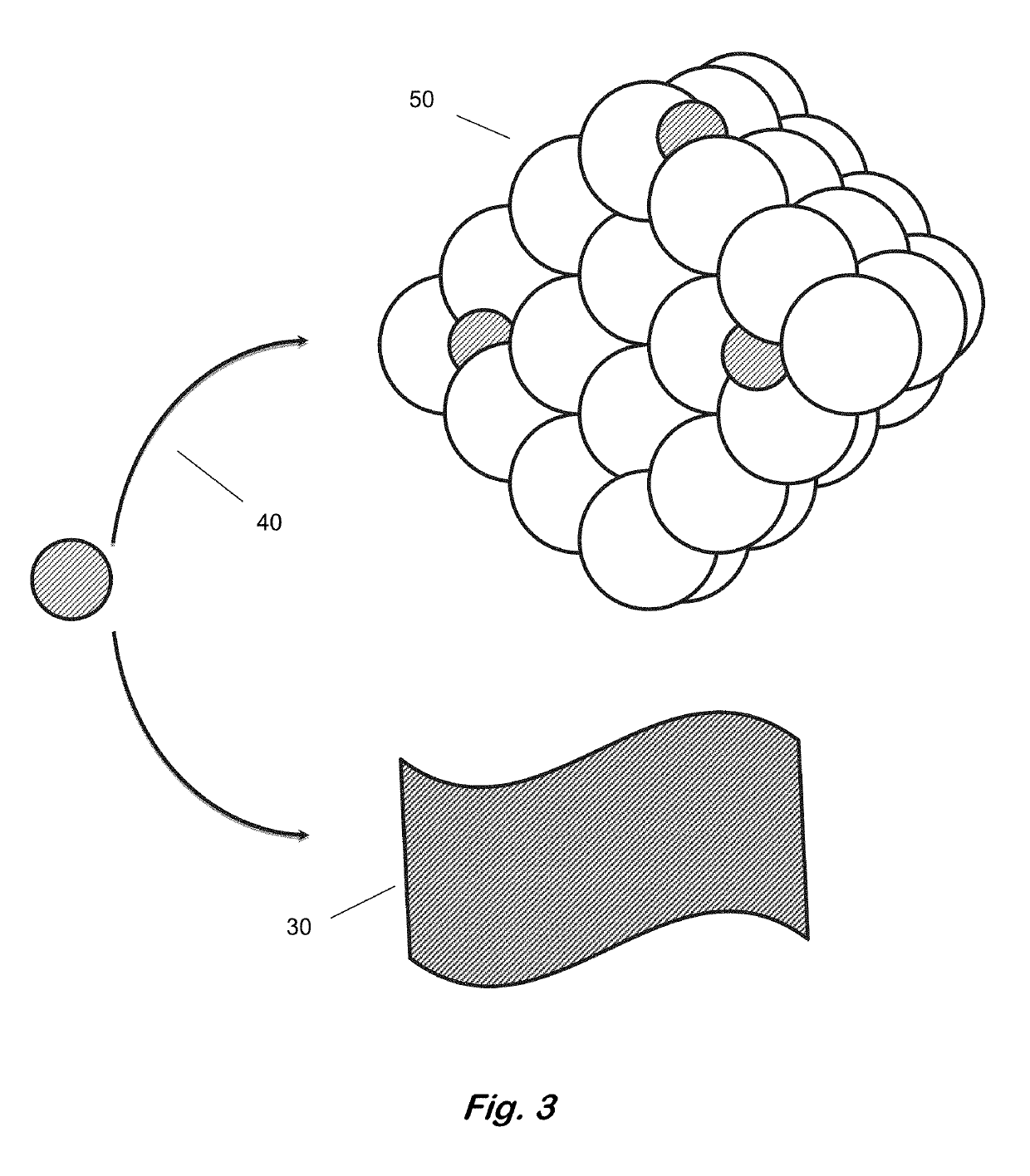Metal nitrides and/or metal carbides with nanocrystalline grain structure
- Summary
- Abstract
- Description
- Claims
- Application Information
AI Technical Summary
Benefits of technology
Problems solved by technology
Method used
Image
Examples
example 1
Zirconium Nitride / Zirconium Carbonitride—
[0058]Zirconium nitride (ZrN) and zirconium carbonitride (ZrC0.5N0.5) were synthesized from blends of zirconium metal (Zr) and TPEB. Alternatively, ZrN and ZrC0.5N0.5 composites were synthesized from blends of zirconium hydride (ZrH2) and TPEB. Zr was blended together with TPEB for a ratio of 6.8 g of Zr per 1.0 gram of TPEB, and ZrH2 was blended together with TPEB for a ratio of 6.4 g of ZrH2 per 1.0 gram of TPEB. The two materials were blended together in a steel ball mill with steel grinding media and used nitrogen gas (N2) or methylene chloride (CH2Cl2) organic liquid as the media that filled the void space between grinding media and metal and polymer particles. The blended materials were compacted into discs and heated in a tube furnace under flowing N2 gas up to 1400° C. Table 1 summarizes the resulting densities of this material.
TABLE 1DiskVolumetricArchimedes′ZirconiumGrindingMassWidthThicknessVolumeDensityDensityPrecursorMedia(g)(mm)...
example 2
[0063]Zirconium Nitride Two-Step Synthesis Composite—
[0064]Zirconium nitride (ZrN) ceramic monoliths were synthesized via a two-step approach. In the first step, three-ingredient blends of ZrH2, TPEB, and melamine (C3H6N6), as well as three-ingredient blends of Zr, TPEB, and melamine were prepared using ball milling. N2 gas, hexane (C6H14) fluid, and CH2Cl2 fluid were used to fill the void space between grinding media and sample particles. For materials that used Zr, the precursor blend included 3.06 g Zr; 0.46 g TPEB; and 0.69 g melamine. For materials that used ZrH2, the precursor blend included 6.00 g ZrH2; 0.71 g TPEB; and 1.38 g melamine. The ground particle blends were placed in a tube furnace (as a powder poured into a ceramic boat or compacted into a cold-pressed disc). These materials were heated up to 1400° C. under flowing N2. The resulting material is a zirconium nitride powder. In the second step, the ZrN (hereafter referred to as “bulk ZrN”) synthesized from the first ...
example 3
[0067]Zirconium Nitride Formed Using Nitrogen-Rich Polymer Precursor—
[0068]Zirconium nitride (ZrN) ceramic monoliths were synthesized via a two-step approach. In the first step, two-ingredient blends of ZrH2 and 1,3,5-triazine-2,4,6-triamine (hereafter referred to as “TAM”) were prepared using ball milling. N2 gas, hexane (C6H14) fluid, and CH2Cl2 fluid were used to fill the void space between grinding media and sample particles. The precursor blend was composed of 4.267 g ZrH2 and 0.639 g TAM. The blended powder was placed in an alumina crucible and heated in a tube furnace under flowing N2 gas up to 1,450° C. The synthesis yielded ZrN powder. The second synthesis step blended together 4.267 g of ZrN and 0.639 grams of TAM using ball-milling. The blended powder was compacted into a disc and heated in a tube furnace under flowing N2 gas up to 1,450° C.
[0069]FIG. 10 shows a photograph of the resulting monolith. As revealed with XRD analyses, the resulting disc was composed of ZrN. FI...
PUM
| Property | Measurement | Unit |
|---|---|---|
| Percent by mass | aaaaa | aaaaa |
| Volume | aaaaa | aaaaa |
| Fraction | aaaaa | aaaaa |
Abstract
Description
Claims
Application Information
 Login to View More
Login to View More - R&D
- Intellectual Property
- Life Sciences
- Materials
- Tech Scout
- Unparalleled Data Quality
- Higher Quality Content
- 60% Fewer Hallucinations
Browse by: Latest US Patents, China's latest patents, Technical Efficacy Thesaurus, Application Domain, Technology Topic, Popular Technical Reports.
© 2025 PatSnap. All rights reserved.Legal|Privacy policy|Modern Slavery Act Transparency Statement|Sitemap|About US| Contact US: help@patsnap.com



